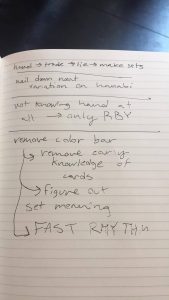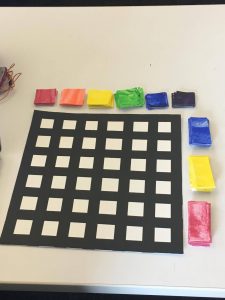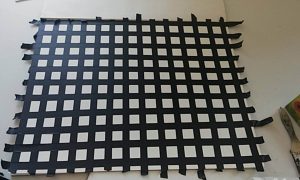After last week’s feedback, we did a major overhaul of the game.
It went from cards only to cards and a board with pieces. We got rid of the mean-spirited teaming up/lying element while retaining the questionable trust element by having players play as single parties only. I think the most drastic changes made were the simplification of the game and the pace; the rhythm here is meant to be fast. It is also not gradient based anymore, which makes it easier.
TRUE COLORS (a better name would be
COLOR WARS!)
*improvements I think would help
things I would scrap after observing yesterday’s playthrough
This is a territory claiming, cooperative competitive card and board game centered around making colors and balancing trust between players.
Materials: 6×6 grid board, at least 6 tiles of the basic colors of the rainbow (red, orange, yellow, green, blue, purple), at least 30 primary color cards (10 or more each of red, yellow, blue)
3 to 5 players (could be modified to fit more players, just adjust materials)
Goal: claim the most space on the grid by trading primary color cards for tiles to place on the grid. Whoever has the most territory wins.
Instructions:
- Each player receives 5 random primary color cards.
- Players cannot see their own cards; the color side of their cards will face the other players.
- Players take turns. Players can perform one action per turn: trade a card with another player, or claim a tile on the board using the cards they have. *
- To claim a tile, the player must turn in the primary colors that that color is composed of (see Cards).
- If a player is the first to claim a color on the board, no one else can claim that color in the next
round**. When a player claims a tile, they must discard the rest of their cards until the next round.In each round, every player has a turn. At the end of the round, players must discard their current cards and receive new random cards to use in the next round.After three rounds***, the player with the most tiles wins.
Cards:
- Players should have 5 cards at a time.
- When a player claims a tile using their cards, those used cards must be discarded. The player then draws the appropriate amount of cards from the deck.
- Tiles are gained by exchanging the primary color cards that the color of the tile is composed of.
- primary color tile = 3 cards of their color
- red = 3 red
- yellow = 3 yellow
- blue = 3 blue
- orange = 2 red + 2 yellow
- green = 2 yellow + 2 blue
- purple = 2 blue + 2 red
- primary color tile = 3 cards of their color
*Players should also be able to ask questions about their cards to other all players, who can choose whether or not to answer, to answer truthfully, or to lie.
**turn
***The game should continue until all the space on the board is claimed.
Unfortunately, I had to make all the game pieces as one group member had work the entire day before it was due, and the other thought it was due next week (Wilson……….). This was stressful, but I managed to finish right before class.
I should have used heavier paper that could not be seen through when next to a sunny window. Ah, budget and time restraints.
The presentation was not great. We need to practice presenting; we did too much explaining and not enough playing, and we were way too high strung/strict about players following every single rule.
It ended up being 20 minutes of talking and less than 5 minutes of playing. Players were very confused and disgruntled, and some cheated by looking at the color of their own cards.
Things would have been better if we’d scrapped all the extraneous rules and went with the simplest version possible, but overall I don’t think we have to do much tweaking to the core of the game. It is easy to understand and easy to play.
I do think a version with more players and more space on the could work with a slight adjustment of the number of tiles and cards total, and a differently sized board, which is easy enough to make.
It makes more sense for players to take tiles and place them on an empty board than to take tiles away from a completely rainbow board. We also need a way to keep track of whose tile is whose – a sheet with each player’s name and tally marks of what tiles they have would do. And we can add the placement of tiles on the board into making the game more challenging, like linking tiles together to make a chain, being specific of which color group goes where, etc.
We did have a lot of trouble combining the Bridge mechanic with the Hanabi mechanic. Unsure how to resolve that issue.
The other thing that Wilson, Macy, and I agree on is that the time we have for projects feels too short? We were rushed and strapped for time. We made the first draft, we playtested/received feedback, and then BAM the project was due. Yesterday seemed like the second playthrough. Maybe it would be better if the number of projects were cut back a little to give us more time to refine work – 3 weeks per assignment instead of 2?
This project was far more enjoyable than any Unity project we have ever done.
It’s understandable that the game design program is heavily based in digital games; it’s Design and Technology, and most people here want to work in video games after graduation. However, putting more spotlight on analog games would be helpful in festering creativity and diversity in the making process, and of thinking of games in ways that we don’t touch upon as often, especially regarding mechanics. Last year, we didn’t think much about mechanics at all, mostly focusing on some theoretical stuff and technical skills. This project exercised parts of our brains that have not been worked at all since Games 101.
Technology and I do not mesh well. Everyone knows this. I barely passed last year and I will be extremely lucky to pass this semester. Digital work is not tangible. I need to touch things to be able to work with them properly.
If we did board games the whole semester, both Macy and I would be perfectly content. That would be difficult in slightly different ways than making digital games are, and yes, we would be behind in technical skill, but I don’t know if I want to work in games after school ends, or if I will even live that long. If we were giving the option, I, and probably others would be at least interested in making more than one board game for an assignment.
Only being able to make digital games for school feels limiting.
Also, I am proud to have made a very gay game!!! I came up with the whole gradient/colors/rainbow idea!!! Hohoho.


















